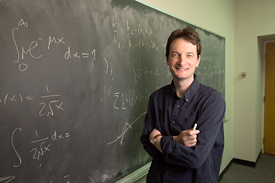
Photo by Austin Thomason, Michigan Photography.
Mark Newman will sometimes spend weeks doing one math problem.
“Just because you do it for a living, doesn’t mean it’s easy — it’s a lot of time scribbling on the blackboard,” Newman says of his research in the Department of Physics, where he is the Paul Dirac Collegiate Professor of Physics.
Though it can be difficult, Newman says he’s “very happy” to be a physicist. “I’ve always been interested in understanding connections.”
It makes sense, then, that Newman studies social networks.
“Most people think Facebook, but when scientists talk about networks, they have a more general definition of any network of people connected somehow. It could be a social network, but it doesn’t have to be online. We study how social networks are important in the spread of ideas, fads, fashion, rumors, news, disease, and more,” he says.
Ask Mark Newman
What moment in the classroom stands out as the most memorable?
A few years ago, I was teaching a physics class and had 15 minutes to spare at the end of lecture. I started talking about the many-worlds interpretation of quantum mechanics — a theory that says there are a large number of parallel universes going on alongside ours. My students were amazed by it, and we had a really great conversation.
What can’t you live without?
My friends, my family, music. Work, of some kind.
What is your favorite spot on campus?
The Arb. I live not far from there and walk there a lot in the summer.
What inspires you?
All sorts of things … the people I work with, my students, my collaborators, a tricky science problem.
What are you currently reading?
I tend to be halfway through an awful lot of things.
Who had the greatest influence on your career path?
My father, he was a scientist and university professor; and a professor at college called James Binney, who was very encouraging.
Newman’s research contributes to many different disciplines, including epidemiology. “If we can find the hubs in a network, which represent the people with the largest number of connections, and vaccinate them, we can prevent diseases from spreading,” he says.
Newman first began studying networks at the Santa Fe Institute, where he worked prior to coming to U-M.
“I was brought on board as someone with a mathematical bent, interested in the modeling side of this, but then I began to find the questions very interesting. I wanted to understand what we see going on about us in an everyday way. It’s immediate and practical,” says Newman of his work, which he now continues at U-M’s Center for the Study of Complex Systems.
Though most of his work involves networks, Newman pursues an interest in cartography on the side. During the 2004 election, he and a student worked on a new way to create maps of election results that used population as a scale. This led to maps of all sorts of other phenomena, which were turned into a book.
Newman also plays jazz piano, and although he did it as a graduate student in England “as a way to earn some extra money,” he now plays “just for fun, though still quite a lot.”
Currently, Newman is working on community structure in networks, which includes finding the best way to identify functional groups within networks.
“In general, there’s so many cool things to work on and not enough time in the day,” he says.
The weekly Spotlight features faculty and staff members at the university. To nominate a candidate, please contact the Record staff at [email protected].

